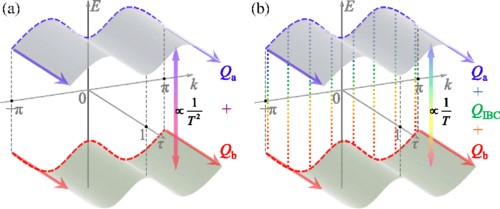Archimedes’ spiral pump, a mechanical device put forward by Archimedes himself that pumps up water in a tube as the blade spins, might be traced back to two thousand years ago. Likewise, now we have the generalized Thouless pump that transports quantum in the micro world, working in some extensively and continuously controlled way similar to Archimedes’ idea, if, taking interband coherence in nonequilibrium initial states into account. Such experimental observation of a generalized Thouless pump for the first time was achieved with a single spin, conducted by the Key Laboratory of Microscopic Magnetic Resonance, Chinese Academy of Sciences(CAS) led by Prof. DU Jiangfeng from University of Science and Technology of China(USTC) and the research group from the National University of Singapore. The progress was published in Physical Review Letters[Phys. Rev. Lett. 120, 120501 (2018)].

Illustration about how interband coherence in the initial state leads to the generalized Thouless pump of duration T. Band dispersion relations are plotted via energy and quasimomentum variables E vs k, and τ represents the time scaled by T. (a) With an initial state being an incoherent mixture of states from different bands, the nonadiabatic correction to the band populations is of the order of 1/T2. The resultant pumping Qa+Qb is a weighted sum of the contribution from each band. (b) With an initial state having interband coherence, the pumping operation induces a population correction of the order of 1/T, whose effect accumulated over T yields a pumping term QIBC that is T independent and continuously tunable./Image by DU Jiangfeng's group
Regardless of interband coherence in nonequilibrium initial states, a Thouless pump in the conventional sense cannot transport quantum continuously, restricted by topological property. In 1983, D. J. Thouless, a prominent physicist in condensed matter and the Nobel Prize in Physics winner, proposed a model that over an adiabatic cyclic variation of the lattice potential, charge transported in a one-dimensional lattice is quantized. Such phenomenon is known as Thouless Pump and considered as the dynamical version of the integer Hall effect for sharing the same topological property. In his research, the initial-state quantum coherence between different energy band is neglected. However, quantum coherence can characterize a great many quantum phenomena and its existence should be further explored.
Recent research has revealed that the interband coherence of initial states does distinctly contribute to the transport quantity. Its contribution is continuously controlled and depends on the energy gap and the rate of change of the time-dependent parameters when triggering the pump. That’s how a generalized Thouless pump behaves in theory that makes it work a little bit similar to Archimedes’ pump.
Now our researchers have run the generalized Thouless pump in practice. Their work piles up from the single Nitrogen vacancy defect system inside diamonds. It is a relatively mature system applied in quantum control and experiments, for it doesn’t take too long to initialize, operate and read out. In experiments, laser pulse is utilized to initialize and read out a single spin, and the microwave pulse is also elaborately designed to achieve precise control of the spin. With this researchers are able to establish two models of energy band and produce the interband coherence of initial states to the largest degree, thus demonstrate the generalized Thouless pump. The experiment confirms that the pump does behave in accordance with the theory above.
Such progress has consolidated the research in quantum pumps and quantum control and hopefully will be applied in the probe of quantum or topological phase transition. The research is also funded by National Natural Science Foundation, CAS, Ministry of Science and Technology and Ministry of Education.
written by WEI Lianyi